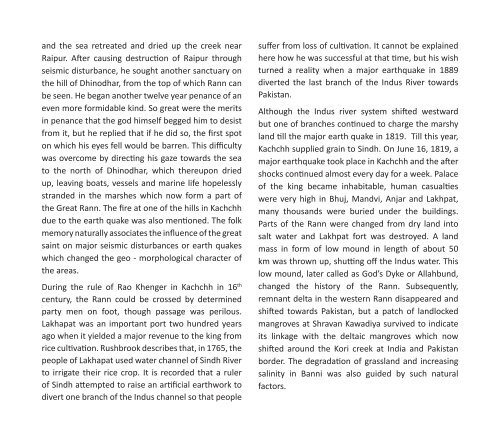Download - Gujarat Biodiversity Board - GSBB
Download - Gujarat Biodiversity Board - GSBB
Download - Gujarat Biodiversity Board - GSBB
You also want an ePaper? Increase the reach of your titles
YUMPU automatically turns print PDFs into web optimized ePapers that Google loves.
and the sea retreated and dried up the creek near<br />
Raipur. After causing destruction of Raipur through<br />
seismic disturbance, he sought another sanctuary on<br />
the hill of Dhinodhar, from the top of which Rann can<br />
be seen. He began another twelve year penance of an<br />
even more formidable kind. So great were the merits<br />
in penance that the god himself begged him to desist<br />
from it, but he replied that if he did so, the first spot<br />
on which his eyes fell would be barren. This difficulty<br />
was overcome by directing his gaze towards the sea<br />
to the north of Dhinodhar, which thereupon dried<br />
up, leaving boats, vessels and marine life hopelessly<br />
stranded in the marshes which now form a part of<br />
the Great Rann. The fire at one of the hills in Kachchh<br />
due to the earth quake was also mentioned. The folk<br />
memory naturally associates the influence of the great<br />
saint on major seismic disturbances or earth quakes<br />
which changed the geo - morphological character of<br />
the areas.<br />
During the rule of Rao Khenger in Kachchh in 16 th<br />
century, the Rann could be crossed by determined<br />
party men on foot, though passage was perilous.<br />
Lakhapat was an important port two hundred years<br />
ago when it yielded a major revenue to the king from<br />
rice cultivation. Rushbrook describes that, in 1765, the<br />
people of Lakhapat used water channel of Sindh River<br />
to irrigate their rice crop. It is recorded that a ruler<br />
of Sindh attempted to raise an artificial earthwork to<br />
divert one branch of the Indus channel so that people<br />
suffer from loss of cultivation. It cannot be explained<br />
here how he was successful at that time, but his wish<br />
turned a reality when a major earthquake in 1889<br />
diverted the last branch of the Indus River towards<br />
Pakistan.<br />
Although the Indus river system shifted westward<br />
but one of branches continued to charge the marshy<br />
land till the major earth quake in 1819. Till this year,<br />
Kachchh supplied grain to Sindh. On June 16, 1819, a<br />
major earthquake took place in Kachchh and the after<br />
shocks continued almost every day for a week. Palace<br />
of the king became inhabitable, human casualties<br />
were very high in Bhuj, Mandvi, Anjar and Lakhpat,<br />
many thousands were buried under the buildings.<br />
Parts of the Rann were changed from dry land into<br />
salt water and Lakhpat fort was destroyed. A land<br />
mass in form of low mound in length of about 50<br />
km was thrown up, shutting off the Indus water. This<br />
low mound, later called as God’s Dyke or Allahbund,<br />
changed the history of the Rann. Subsequently,<br />
remnant delta in the western Rann disappeared and<br />
shifted towards Pakistan, but a patch of landlocked<br />
mangroves at Shravan Kawadiya survived to indicate<br />
its linkage with the deltaic mangroves which now<br />
shifted around the Kori creek at India and Pakistan<br />
border. The degradation of grassland and increasing<br />
salinity in Banni was also guided by such natural<br />
factors.


